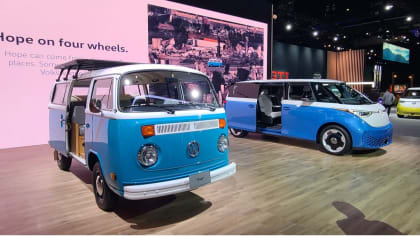Does Route 66 lead to Belgium?
Published on Fri, Jun 28, 1996
By: Len Frank
To the best of our knowledge, this work by the late Len Frank is previously unpublished.
Date written: unknown

Our first real national road was the Lincoln Highway. A bunch of citizens, Carl Fisher, the man who built the Indianapolis Motor Speedway among them, had to get together and lever the various governments and property owners into cooperating or at least not obstructing its construction. It was our first transcontinental highway and somehow, we lost it. As a nation, we have never honored our history—only our historical myth.
One of those myths is US Route 66. That’s the road in the Bobby Troup song: “It winds from Chicago to LA…get your kicks, on Route 66…”. It’s the road that had a TV series named after it–but Buzz and Tod, the guys in the swell `Vette, spent precious little time on it.
“Highway 66 is the main migrant road. 66—the long concrete path across the country, waving gently up and down on the map, from the Mississippi to Bakersfield—over the red lands and the gray lands, twisting up into the mountains, crossing the Divide and down into the bright and terrible desert, and across the desert to the mountains again, and into the rich California valleys.”
That’s what John Steinbeck wrote about it in The Grapes of Wrath. It helped him win a Pulitzer and a Nobel—and he got the route wrong. But he got the main part right—it was the main migrant road. For forty years it moved the population to California.
It hooked Lake Michigan to the Pacific: the architecture, the accents, the shapes of the land, the color of the water, even the skies were different, one end to the other, but the link held. It was more than a road—it was a national bond.
Roads are to automobiles as software is to computers: the concept of software had to exist before the first drop of solder joined two pieces of wire. So too, there were roads—good, hard-finished, useful, purposeful roads—long before the first bark of internal combustion or even the first hiss of steam was heard in the world. It was roads that gave birth to cars.
Art Friedman, now the editor of Motorcyclist, about a dozen years ago, wrote (in “Cycle Guide”) the instructions for getting from his home—coincidently just a few blocks from the end of
Rt.66—in Santa Monica, California to the Daytona Motor Speedway, Daytona Beach, Florida, about 2700 miles away. He suggested that you start with breakfast at the Penguin Coffee Shop—pancakes, I think he specified. Out of the Penguin’s drive and down the onramp onto I-10. Straight ahead for 2600 miles, turn right before you hit the Atlantic—you can’t miss it (the Speedway). Or words to that effect. Predictability and concrete boredom at its worst.
“Life doesn’t happen along interstates. It’s against the law.”…Blue Highways by William Least Heat Moon. Like Steinbeck in Travels With Charley, and Jack Kerouac’s in On the Road, Least Heat Moon misses Rt. 66 in his considerable travels around the US. If this isn’t actually some sort of mythic, literary violation, it should be.
So when a couple of Belgian journalists approached Volvo of Belgium with the idea of driving the prototypical American road, of tracing myth and folklore, seeing America through the windshield of a car, Volvo was quick to agree. There were really six of us on the trip in two Volvo 740 Turbos (one sedan, one wagon). One of the journalists brought his wife, there was a representative from Volvo of Belgium, and a Belgian travel agent who was there to make sure we had someplace to sleep at night and to make sure that we ate in places where the dreaded turistas didn’t lurk in the gravy. I was guide, driver, historian, and supernumerary.
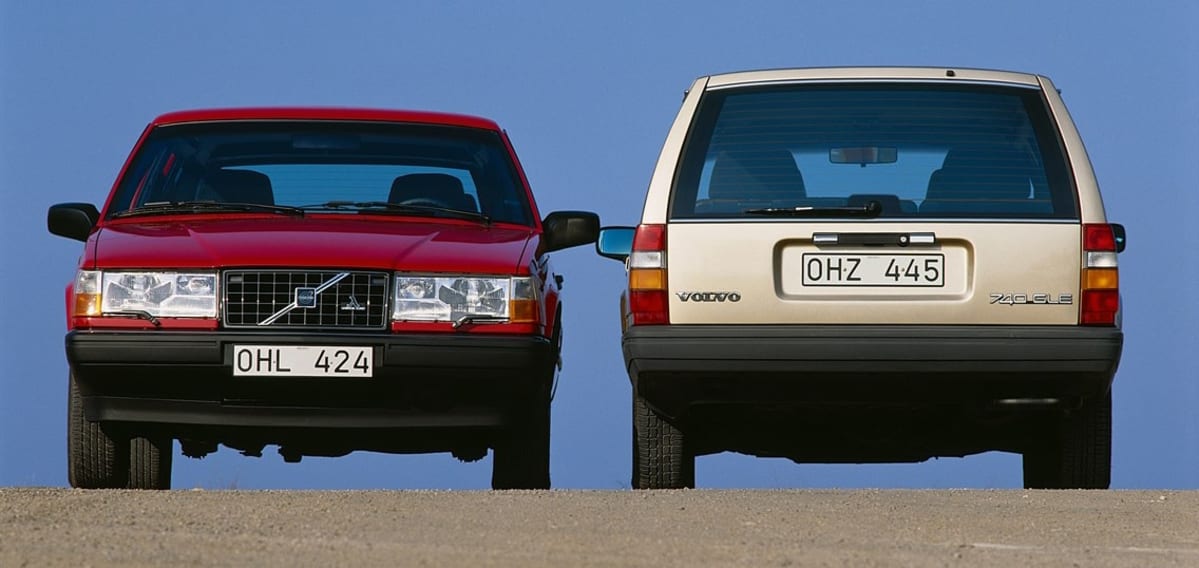
(photo courtesy of Volvo Car Corporation)
Introducing the party to Dr. Tom Snyder was certainly the most useful thing that I did. Dr. Snyder is a psychologist who decided to take a few months out of his practice to pursue his hobby. He wanted to trace Rt.66—it isn’t on the maps anymore, the signs are gone, too many sections of road are gone, buried under interstates, too many of the people whose lives were shaped by the road are gone themselves. The few months have become a few years. Who better than a psychologist to understand obsession?
We were supplied with maps that had 66 traced with Magic Marker. Dr. Snyder had pieced the old Route together from old maps, state and county records, auto club information, local historical societies, word-of-mouth. After a few days on the road, you get a feel for it, the old road. It has a look. It doesn’t violate the landscape, or change topography the way interstates do. Even the pavement looks different.
Travel on Rt.66 really was pretty much east-to-west—a kind of one way street half a continent long—except in our case. The Volvos were already in Los Angeles so we ran it all backwards. Let me say here that this is a road story, not a car story. The Volvos couldn’t have been better or more unobtrusive. They were comfortable with four up for ten and twelve hour days of driving. They swallowed all of our luggage and cameras, gave no trouble except that the sedan with the Volvo rep and travel agent in it was slowly getting destroyed by the stones and gravel kicked up by the wagon on the sections of dirt road we traveled, often at highly illegal speeds, and a few times at what was then double the national speed limit.
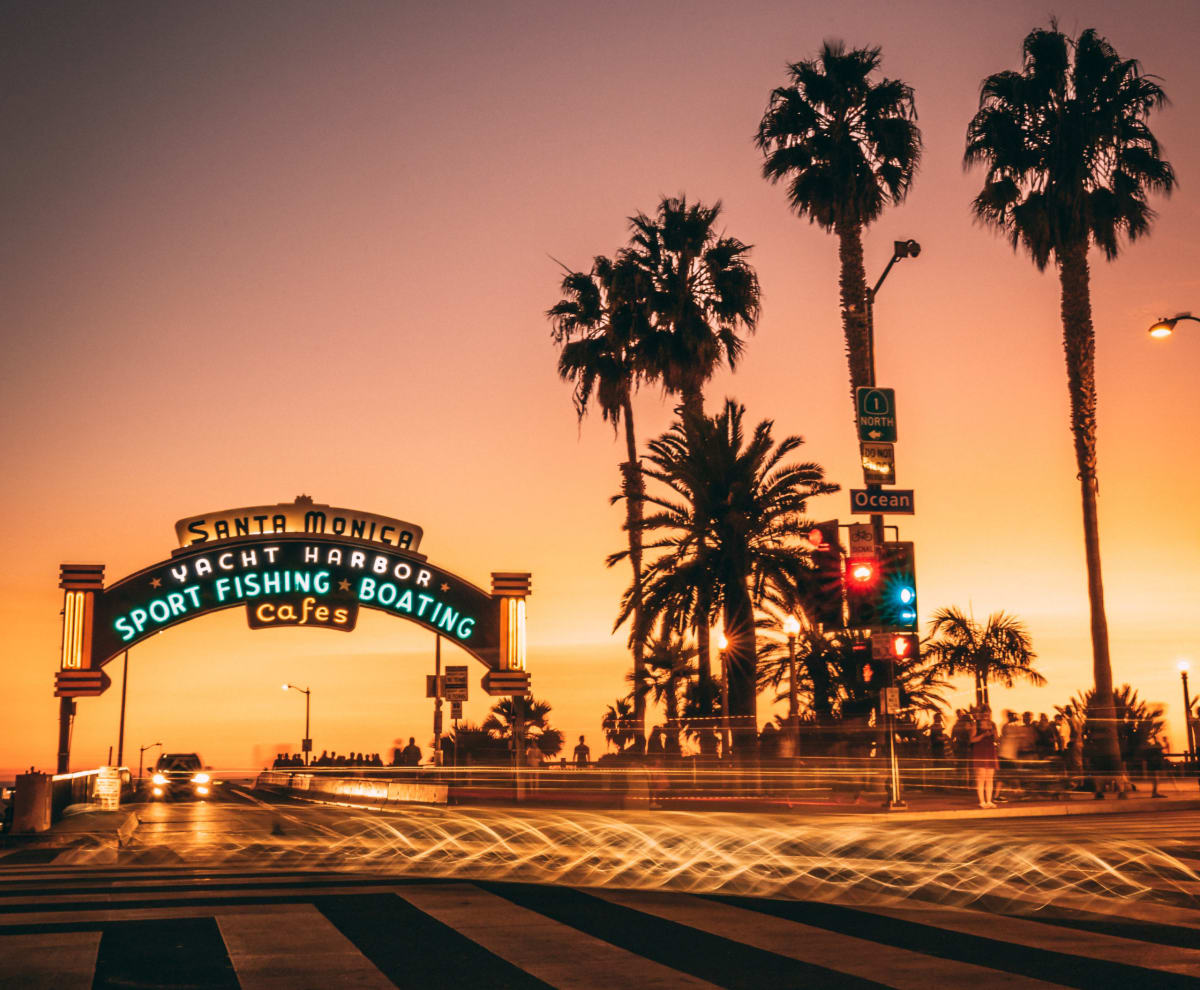
the end of Route 66, but for Len Frank and
his guests, it marked the beginning
(photo courtesy of Kevin Fremon and Unsplash)
On the way from Los Angeles International to their hotel, the Europeans couldn’t get over the number of what to them were rare cars on the roads here: old Mustangs and ‘sixties stuff in general, the occasional ‘fifties fin-tailed car, now coming into vogue in Europe as The Thing in which to be seen, but just another old transportation piece here. Their English was good enough to embarrass me. I tried to explain that most Americans are semi-lingual from decades of inbreeding and TV. My little joke. It doesn’t translate well.
Belgium is about as big as Los Angeles County and has about half as many people. It has been the battleground for two world wars and who knows how many lesser ones. It is, for all its lack of size, divided in language, politics, culture, and sentiment between the Flemish (close to Dutch) and the Walloons (French). It’s an ancient rivalry, the kind Americans don’t yet understand.
The Europeans played tourist for a couple of days, then met for a farewell-to-LA dinner with Dr. Snyder who had just driven in from Kingman, Arizona, where he had been speaking and doing a phone interview with a radio station in Chicago. Rt.66 seems to have taken him over. We had a meeting after dinner, looked at maps, got advice about things we couldn’t/mustn’t miss. I had made the mistake of assuming that Kerouac’s On the Road had raced back and forth over Rt.66. Like the Joads in Grapes of Wrath, Sal and Dean and Marylou had crossed the country in a Hudson. I wasn’t exactly suggesting that we should be making the trip in a Hudson, just that Hudsons had more literary authority than Corvettes on 66. After all, even if Sal, Dean and company had never been on Rt.66, they like the Joads, are frozen for all time, while Buzz is now playing Vegas and Tod is selling real estate in San Diego. As if you cared.
The hotel where the Europeans stayed was, appropriately, on Santa Monica Boulevard where Rt.66 ends and where we began too early the next morning. From there it was freeways and then surface streets out of the LA basin—I tried to point out the old motels and cafes, the old gas stations that marked the route as certainly as any sign, but the welter of LA is taking over and we finally gave up and took—sigh—the interstate out.
Following the maps we were soon paralleling the interstate on a narrow two lane road–a situation that would become commonplace in the next five days. I was trying to explain chili and frozen custard and chicken-fried steak, barbecue, and Tex-Mex food. The interstate moved straight ahead, turned for nothing, rolled not at all. But the land under 66 dips and rolls, the temperature changes with a fifteen or twenty foot change in altitude, the air doesn’t smell like diesel fumes, road signs are perforated with bullet holes as if the world wars had moved through here instead of Belgium. When we wanted to, we moved faster than the traffic on the interstate. When we wanted to, we stopped.
The Belgians were fascinated by the derelict cars sprinkled across the desert–nothing like that in Europe. Stripped, burned, bullet-riddled. Violence. I was beginning to see what had been in front of me daily. The sheer scale of America can be intimidating and liberating at the same time. They were fascinated by the differences in local laws, especially those regulating alcohol. Nothing like that back home.
Although the signs are gone—except in Gallup, New Mexico—it’s possible to navigate with Bobby Troup’s lyric: St.Louie, Joplin, Missouri, Oklahoma City (mighty pretty?), Amarillo, Gallup, New Mexico, Flagstaff, Arizona, don’t forget Winona, Kingman, Barstow, San Bernardino…
It’s hard to give an exact figure but it seems possible to do about half the distance from Chicago to LA on the old road. It misses the franchise strips and shopping centers, it passes down America’s main streets—I was trying to see them through European eyes and what I saw was sad. What was America is too often sad, tired, decayed, dying, dead. Those gold and red and blue franchise roofs have a terribly temporary look, but they are America. They, like modern cars, don’t age well. There is no restoration for them.
There are amazing things out there. Dr. Snyder is afraid that if it gets too well known, gets to be part of the Motorhome Circuit, it will turn into a 2000 mile theme park and thus be lost as certainly as if it were all bulldozed like too much of it has.
Because travel agents are travel agents, there were too many safe hotels and restaurants—too much traveling on “plastic,” too much skipped to make a reservation on time, too many $75 hotel rooms that could have been the one from the night before or the night ahead.
The next time, I tell myself, I will find, what Least Heat Moon calls “five-calendar cafes,” I will talk with the old men sitting in the squares and the old women running the local historical museums, I will go more than a hundred yards off the road to check out a promising junkyard. I’ll hang out until Saturday night for the stock car races, and since I’m there on Sunday anyway, stay for the Strawberry Festival (or Flower, or Pumpkin, or Rhubarb).
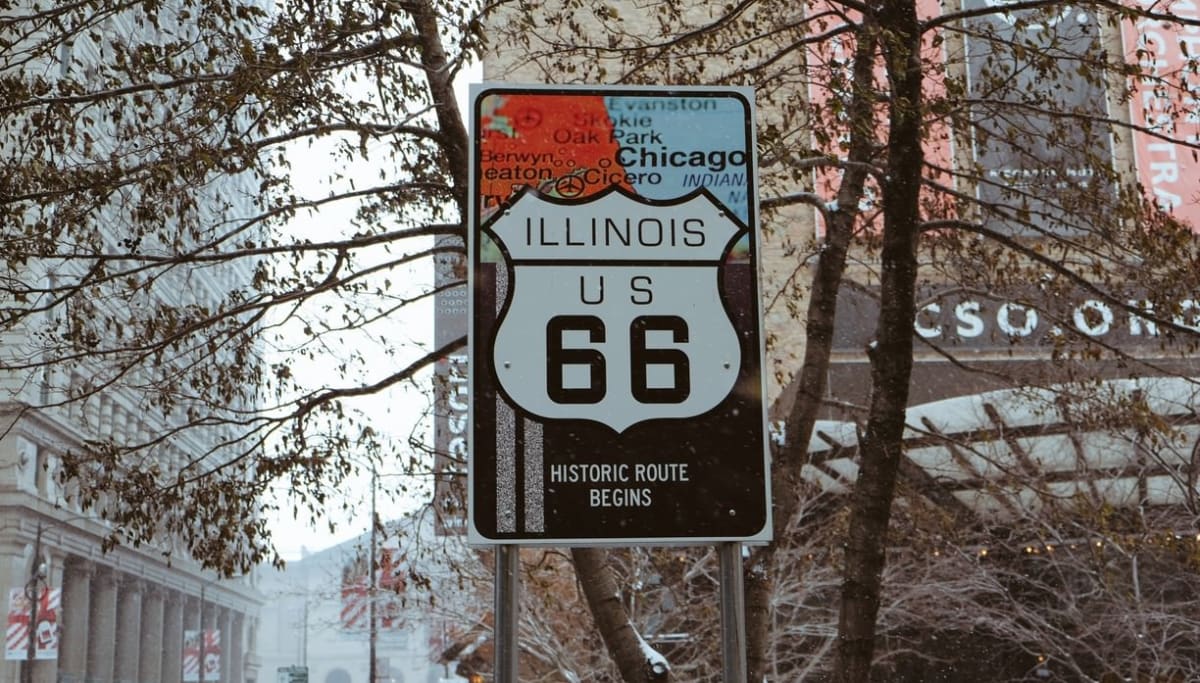
(photo by Awwway, courtesy of Trover)
When we got to beautiful Chicago, we looked at the buildings and museums and galleries, found some great used bookstores, spent money. I saw the Europeans off, thought about it all for a couple of hours, then drove back to LA, getting my kicks, on Route 66.
I’m ready to do it again.
Top image: Historic Route 66 Amboy in Amboy, California (Dietmar Rabich – Wikipedia Commons)
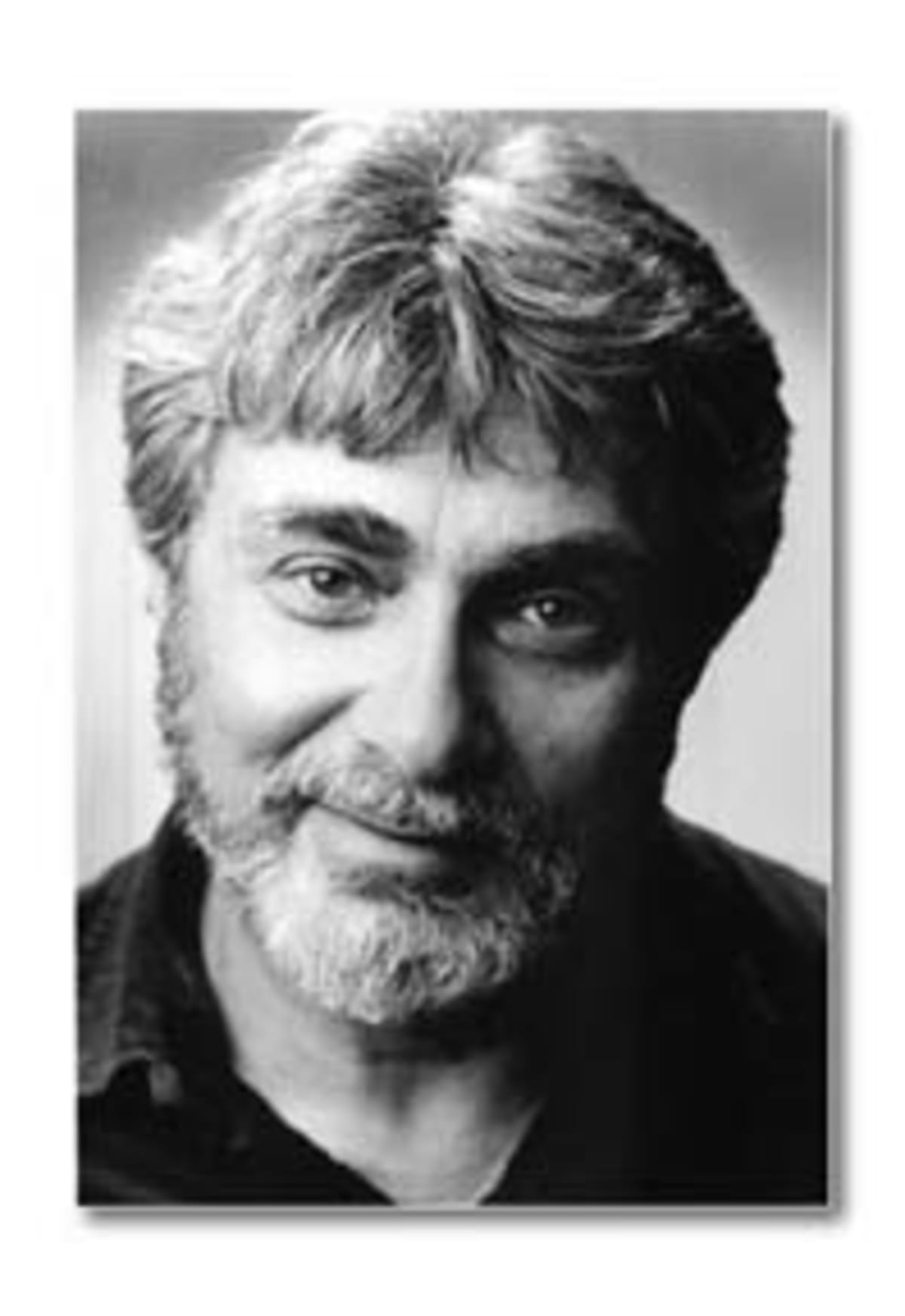
The late Len Frank was the legendary co-host of “The Car Show”—the first and longest-running automotive broadcast program on the airwaves. Len was also a highly regarded journalist, having served in editorial roles with Motor Trend, Sports Car Graphic, Popular Mechanics, and a number of other publications. LA Car is proud to once again host “Look Down the Road – The Writings of Len Frank” within its pages. Special thanks to another long-time automotive journalist, Matt Stone, who has been serving as the curator of Len Frank’s archives since his passing in 1996 at the age of 60. During the next few months, we will be re-posting the entire collection of “Look Down the Road”, and you’ll be able to view them all in one location under the simple search term “Len Frank”. – Roy Nakano
